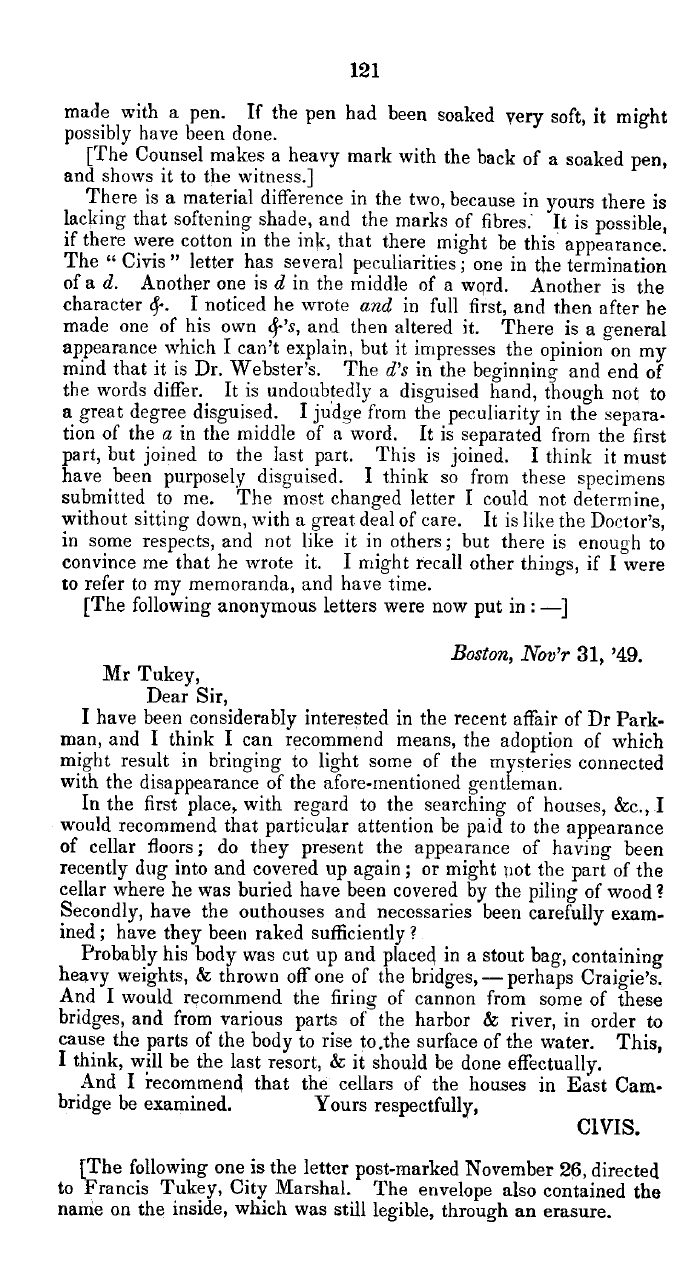|
121
made with a pen. If the pen had been soaked very soft, it might
possibly have been done.
[The Counsel makes a heavy mark with the back of a soaked pen,
and shows it to the witness.]
There is a material difference in the two, because in yours there is
lacking that softening shade, and the marks of fibres: It is possible,
if there were cotton in the ink, that there might be this appearance.
The °° Civis " letter has several peculiarities; one in the termination
of a d. Another one is d in the middle of a word. Another is the
character (~. I noticed he wrote and in full first, and then after he
made one of his own c-'s, and then altered it. There is a general
appearance which I can't explain, but it impresses the opinion on my
mind that it is Dr. Webster's. The d's in the beginning and end of
the words differ. It is undoubtedly a disguised hand, though not to
a great degree disguised. I judge from the peculiarity in the separa-
tion of the a in the middle of a word. It is separated from the first
part, but joined to the last part. This is joined. I think it must
have been purposely disguised. I think so from these specimens
submitted to me. The most changed letter I could not determine,
without sitting down, with a great deal of care. It is like the Doctor's,
in some respects, and not like it in others; but there is enough to
convince me that he wrote it. I might recall other things, if I were
to refer to my memoranda, and have time.
[The following anonymous letters were now put in:
-
Boston, Nov'r 31, '49.
Mr Tukey,
Dear Sir,
I have been considerably interested in the recent affair of Dr Park-
man, and I think I can recommend means, the adoption of which
might result in bringing to light some of the mysteries connected
with the disappearance of the afore-mentioned gentleman.
In the first place, with regard to the searching of houses, &c., I
would recommend that particular attention be paid to the appearance
of cellar floors; do they present the appearance of having been
recently dug into and covered up again; or might iiot the part of the
cellar where he was buried have been covered by the piling of wood?
Secondly, have the outhouses and necessaries been carefully exam.
ined; have they been raked sufficiently ?
Probably his body was cut up and placed in a stout bag, containing
heavy weights, & thrown off one of the bridges,--perhaps Craigie's.
And I would recommend the firing of cannon from some of these
bridges, and from various parts of the harbor & river, in order to
cause the parts of the body to rise to.the surface of the water. This,
I think, will be the last resort, & it should be done effectually.
And I iecommend that the cellars of the houses in East Cam-
bridge be examined. Yours respectfully,
CIVIS.
[The following one is the letter post-marked November 26, directed
to Francis Tukey, City Marshal. The envelope also contained the
name on the inside, which was still legible, through an erasure.
|

